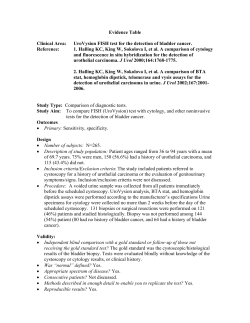
Superficial Bladder Cancer- TCC Barry Stein, M.D.
Superficial Bladder Cancer- TCC Barry Stein, M.D. Prevalence 2008 data Total of 68,610 new cases 51,230 males 17,580 females Mortality Total is 14,100 68,000 new pts annually 54,400 pts will have superficial tcc 38,080 will have a recurrence 8160 pts will upgrade or upstage 5,400 pts will develop metastases or die Year 2 there would be 54,400 + 38,080 pts in the pool This continues on ad infinitum Plus any pts with upper tract tumors + bladder tumor Breakdown of cases Cause of TCC Genetic Issues • Genetic changes ie. oncogenes play a role • Suppressor gene mutations ie. – P53- Ch 17 – Rb- Ch 13q – 9p21 region of Ch 9 8 Patient Presentation • • • • • Gross Hematuria in 85% Microscopic hematuria Pain on voiding UTI Incidental finding on CT or US study The Hematuria “Tattoo” Upper tract imaging Cystoscopy Cytologic exam Work Up • Upper tract imaging – CT scan – IVU • Cystoscopy – Flexible – rigid • Some type of “cytology” test • Then, after dx a tumor, a TURBT is performed CT Scan shows papillary lesion CT Scan of Bladder Ca-solid Upper Tract Tumor Office Flexible Cystoscope Rigid Cystoscopes 16 Superficial TCC- 80% CIS (Flat Lesion)- 1-2% Invasive Cancer- 20% Let’s Talk About “Cytology” 20 AUA Guidelines 2001 Risk Factors What’s the Trouble with Cytology? • The following slides with comments on what’s the trouble with cytology are taken from a recent editorial in the Journal of Urology written by William Murphy • Reference JU 176: 2343-2346, 2006 What’s the Trouble with Cytology? • In my opinion the decades long dissatisfaction with UC as a method for detecting urothelial neoplasms can be condensed into the 3 somewhat related themes of • 1) inaccurate histological classification and terminology • 2) inappropriate clinical approach to urothelial neoplasms • 3) lack of confidence among pathologists in general and cytopathologists in particular. What’s the Trouble with Cytology? • Many urological pathologists do not claim to have proficiency in cytology and many cytopathologists have not been specifically trained in urinary cytopathology. • When assessing a urinary specimen, it is not uncommon for cytopathologists to attempt an extrapolation of criteria learned for uterine cervical lesions. NMP-22 Urology 66, supplement 1, 35-63, 2005 • This paper studied: – – – – 93 pts with known bladder cancer 42 pts with benign disease 50 normal volunteers And compared BTA, NMP 22 and standard urine cytology 32 Results: 33 Results- levels vs grade 34 Compared: NMP22, BTA, telomerase activity, hgb dipstick and voided cytology 35 Results- compared to cysto and bx findings 36 37 Gupta et al - recurrence rates 38 Dogs trained to smell bladder cancer in urine Man's best friend could help fight disease, scientists say New Lab Test in development 40 Diagnosis Demographics Total Tested Population (1331) vs Patients with TCC (79) 80 Total TCC 64 48 32 16 Av Age yr %male %female TCC 79 / 1,331 (6%) 0 Sensitivity for Detecting TCC: Diagnosis 100 90.9 80.0 77.8 75 60.0 47.1 51.7 47.1 44.4 50 38.5 20.0 17.2 25 11.1 6.3 .0 Ta T1 Tis T2 + Low Grade NMP22 Test = 57% 0 Md Grade High Grade Cytology = 16% Improved Detection with NMP22 BladderChek Test and Cystoscopy Muscle Invasive All Cancers & NMP22 Test 91% (10/11) 94% (74/79) Cystoscopy alone 55% (6/11) 86% (68/79) Cystoscopy P=0.014 Cancers not seen by cystoscopy but detected by NMP22 Test: Bladder CIS, T2, T3; Ureter T2; Renal Pelvis T1, T3 43 Monitoring (Surveillance) Demographics 80 Total TCC 64 48 32 16 Av Age yr %male %female Total population = 668 Patients with tumors = 103 (15%) 0 Sensitivity for Detecting Cancer: Monitoring 100 90.9 75.0 64.7 50.0 50 43.8 37.5 36.0 75 31.6 19.4 25 12.5 6.3 Ta .0 T1 Tis T2 + NMP22 Test = 50% 5.4 .0 Low Grade Md Grade 0 High Grade Cytology = 12% Improved Detection with NMP22 BladderChek Test and Cystoscopy Muscle Invasive Cystoscopy & NMP22 Test 91% (10/11) All Cancers 99% (102/103) P=0.005 Cystoscopy alone 64% (7/11) 91% (94/103) Cancers not seen by cystoscopy but detected by NMP22 Test: Ta G1, 2 Cis G3, T1 G3, 2 T2 G3, 2 T4 G3 46 Relative Risk- High Grade Relative Risk- Low Grade Bladder Cancer Detection Algorithm Pathway NMP22 Test(NEG) #1 Cystoscopy (NEG) Pathway #2 Pathway #3 NMP22Test (POS) Cystoscopy (NEG) NMP22Test (POS) Result: >99% Negative Predictive Value Action: Standard Surveillance Result: Potential for undetected cancer Action: - More intensive investigation - Review/Schedule upper tract tests - Follow up within shorter interval Result: - Up to 99% of cancers detected; - Elevated risk of muscle invasive and/or high grade cancer Cystoscopy (POS) Action: Prioritize for biopsy Pathway NMP22 Test(NEG) #4 Cystoscopy (POS) Result: Greater likelihood nonmuscle invasive and low grade cancer Action: Standard biopsy Treatment Superficial TCC 50 Initial Treatment Staging WHO Classification Urology 66, supplement 1, 4-34, 2005 Papillary UN of LMP Papillary Carcinoma LG High Grade TCC Progression Rates Treatment Paradigm-I What is the risk of dying of this? • Low risk of progression- 10% • Ta- Grade 1 • Ta- Grade 2 • T1- Grade 1 Treatment Paradigm-II • Moderate risk of progression- 25% • Ta- Grade 3 • T1- Grade 2 Treatment Paradigm-III • High risk for progression- 50% • T1- Grade 3 • CIS 62 Intravesical Chemotherapy • Indications: – Ablation – Prophylaxis – Prevent progression – CIS • Agents: – BCG – MMC – Adriamycin – Interferon At the end of the day… • ~80% 5 yr survival rate for superficial ca – Most of the deaths are from Grade 3, T1 • ~60% 5 yr survival rate for invasive ca – We need earlier diagnosis and better chemotherapy 64 Thank you for joining me Barry Stein, M.D.
© Copyright 2025





















